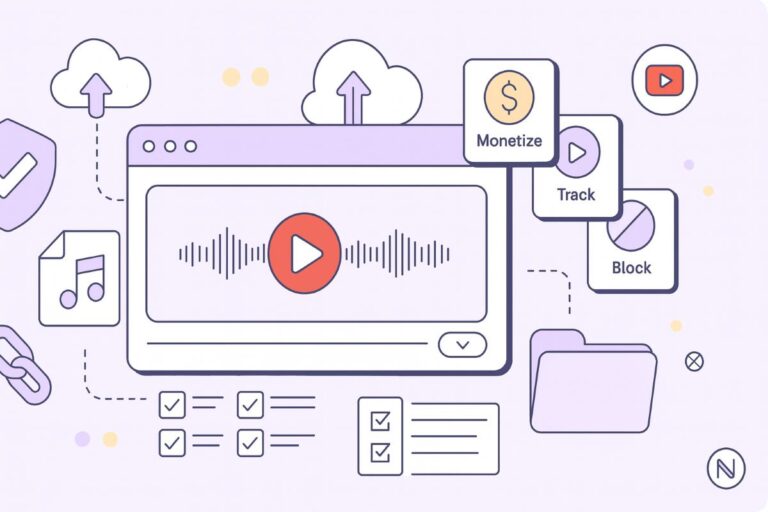How to Manage Music Licensing Fees in a Tight Budget
Audiodrome is a royalty-free music platform designed specifically for content creators who need affordable, high-quality background music for videos, podcasts, social media, and commercial projects. Unlike subscription-only services, Audiodrome offers both free tracks and simple one-time licensing with full commercial rights, including DMCA-safe use on YouTube, Instagram, and TikTok. All music is original, professionally produced, and PRO-free, ensuring zero copyright claims. It’s ideal for YouTubers, freelancers, marketers, and anyone looking for budget-friendly audio that’s safe to monetize.
Cutting music licensing costs doesn’t have to mean cutting corners. If you’re a marketer, creator, editor, or agency, the real savings come from smarter planning, sharper contracts, and tighter workflows, not from sacrificing quality. This guide shows you how to scope projects upfront, negotiate the right levers, avoid operational waste, and build a governance model that keeps budgets in check. You’ll also get KPIs that actually matter and an SOP to make compliance simple.
Strategy: Control Scope, Not Creativity
Music licensing costs spiral when scope is vague or reactive. The goal isn’t to trim music until campaigns feel flat, but to set clear priorities, negotiate terms upfront, and design assets for long-term reuse.
Prioritize What Lasts
Evergreen tracks carry more value because they work beyond one campaign. Focus on product education, onboarding flows, brand how-tos, and FAQs where music supports core identity. A license here gives returns across months, not days.
Reusable motifs save money by anchoring brand identity. A two- to five-second logo sting or a loopable bed adapts easily across ads, videos, podcasts, and presentations without extra fees.
Build Modular Edits
Think like an editor at the planning stage. Map out 6, 10, 15, 30, and 60-second cutdowns with room for localized versions and clean endings. This avoids paying for separate tracks when formats change.
Stems and alternate mixes give flexibility for narration, voice-over, or platform variations. A single track can produce quiet VO-friendly backgrounds, instrumental highlights, or stripped-down mixes without rebuying music for each case.
Secure Multi-Use Where Allowed
A series or campaign license saves more than one-off coverage. When one license covers multiple uploads, episodes, or formats, you avoid incremental costs and keep creative options open across channels.
Assignment clauses and client-named licenses protect you during handovers. If an agency or vendor is involved, these terms ensure the music stays usable without forcing a repurchase when ownership shifts.

Contract Levers That Save Money
Licensing terms are rarely fixed. Contracts hold levers that shift cost and flexibility if you know how to pull them. By structuring deals to match growth, markets, and actual risk, you can keep fees predictable and fair.
Step-Deals (Ladder Rights As You Grow)
Start with organic and social channels where risk is low and audiences are smaller. Pre-price upgrades for paid ads, connected TV, and eventually broadcast. This ladder approach keeps budgets lean until scale justifies expansion.
Add retroactive coverage language to shield you from unexpected success. If a clip goes viral or a campaign suddenly grows, you can upgrade licensing after the fact instead of paying penalties or scrambling for new rights.

Options to Extend (Time & Regions)
Short terms keep costs down early. A three- to six-month license with clear extension pricing avoids overcommitting. When campaigns prove their worth, you can extend instead of paying upfront for time you may not need.
Focus licensing on core markets first. Add clauses that let you expand into new regions when campaigns scale internationally. This prevents overspending on territories you may never use.
Narrow What You Don’t Need
Not every project needs exclusivity. Use non-exclusive licenses where music supports but doesn’t define brand identity, saving buyouts for campaigns where the track is central to recognition.
Remove unused channels from the deal. If radio or podcasts aren’t in scope, exclude them. Add those channels later if they become relevant, instead of paying blanket coverage now.
Risk & Remedies (Pay for Certainty, Not Bloat)
Set indemnity limits to match your risk profile, not the publisher’s worst-case scenario. Require a claim-release service level agreement of 24 to 72 hours so you stay protected without buying oversized legal guarantees.
Negotiate replacement and cure clauses. If a track creates legal issues, the licensor must swap or fix it quickly. This way you’re paying for real protection, not inflated fees based on rare hypotheticals.

Operational Tactics (stop leakage before it happens)
Budgets leak when teams scramble for tracks, lose files, or miss renewals. The fix is consistent discipline. With clear systems for playlists, naming, renewals, and disputes, you prevent waste before it starts.
Pre-Approved Royalty-Free Playlists
Build internal libraries of royalty-free or production tracks that already include stems and options for ads or connected TV. When campaigns spin up, you have ready-to-use music without renegotiating terms or chasing permissions.
Tag tracks by BPM, key, mood, and use case. This way, editors swap music instantly instead of auditioning dozens of files. Speed here saves hours and avoids paying for last-minute licensing.
.jpg)
Stems/Alt-Mix Kits
Keep a master folder with high-quality WAVs and stems broken into drums, bass, melody, pads, and FX. Add instrumental, underscore, and loop beds to cover every possible edit. Shared storage makes these resources visible across teams.
With alt mixes in reach, you avoid unnecessary repurchases. Editors can pull quieter VO-friendly beds, build cutdowns, or strip tracks to essentials without paying again for “new” licenses. This flexibility extends the life of each track.
Version Naming Discipline
Use a consistent file naming system that covers project, track, BPM, key, version, duration, and mix type. A structure like Brand_Project_Track_BPM_Key_v1-[60|30|15|6]_mixType.wav ensures any editor knows exactly what they’re opening.
This discipline stops duplication and errors. Instead of paying for new licenses when files go missing, teams can instantly identify the right version, drop it into the timeline, and keep the project moving without extra cost.
Renewal Calendar & Ledger
Set automated reminders 90, 30, and 7 days before each license expires. A shared calendar prevents gaps that could trigger takedowns or retroactive fees. Everyone knows deadlines before they become problems.
Maintain a simple ledger with media, term, territory, licensee, usage caps, URLs, and ticket numbers. This single sheet provides instant visibility, letting finance, legal, and creative stay aligned on rights and renewals.
Claim Packet SOP
Prepare a standardized packet for disputes. Include the license PDF, invoice, supplier URL, track ID or ISRC, timestamps, and allowlist emails. Keep it stored in one folder so response time drops from days to minutes.
Attach a prewritten dispute macro to the process. With one click, teams can send all required evidence to platforms or claimants. Fast, consistent responses minimize disruption and prove compliance without draining resources.
Vendor Consolidation & Governance
Licensing chaos grows when too many vendors, accounts, and files scatter across teams. By consolidating suppliers, setting permissions, and enforcing review cycles, you cut waste, simplify oversight, and make sure every track is compliant and accounted for.
Consolidate the Core, Keep a Fallback
Rely on one primary platform for about 80 percent of your music needs. This centralizes contracts, renewals, and reporting while making it easier for teams to know exactly where to find approved tracks.
Keep one or two specialty vendors as backups. These fill gaps for edge genres, niche moods, or high-profile tentpole campaigns. The fallback prevents overpaying for exclusives while maintaining creative flexibility.
Seats & Permissions
Set clear role-based access: Admins handle contracts and billing, Editors pull and upload tracks, Reviewers approve usage. This structure eliminates confusion about responsibilities and reduces the risk of someone buying unapproved licenses.
Enable single sign-on, run regular seat audits, and create brand-specific workspaces. These steps ensure every license sits under the right account, preventing shadow purchases and lost invoices.
Paper & Privacy
Make sure each vendor supports proper documentation. Exports for invoices, VAT, and purchase orders should flow directly into your finance system. This reduces friction and avoids last-minute hunts for paperwork during audits.
Check that data processing agreements (GDPR compliance) are signed and stored. Published support SLAs provide clarity on response times when disputes arise, ensuring you’re not left waiting while a campaign is offline.
Review Cadence
Run quarterly vendor reviews. Measure claim rates, average release times, upgrade spending, and catalog freshness. These numbers show if the vendor still delivers value or if terms need renegotiation.
Tie review findings to action. Replace weak vendors, negotiate better terms, or shift budgets where catalog quality and support are strongest. Governance here ensures you pay for performance, not empty promises.
Measure and Iterate (What Proves It’s Working)
A strategy only matters if you can show it works. By tracking the right metrics, you separate guesswork from evidence and uncover where licensing choices save money, speed up workflows, or strengthen campaigns.
Core KPIs
Time-to-publish is the clearest efficiency signal. Measure the gap from creative brief to live asset. Shorter cycles show that playlists, naming, and licensing discipline keep production moving instead of stalling in admin delays.
Track claim incidents and the average time it takes to get them released. Fewer disputes and faster resolution prove that vendor governance, clear contracts, and organized claim packets protect campaigns without disrupting schedules.
Compare upgrade spending against the plan. Step-deals only work if they scale predictably. Tracking this spend shows whether you’re moving up the ladder at the right pace or leaking budget through unplanned jumps.
Calculate effective track cost (ETC). Add license fees, expected renewals, and admin hours multiplied by internal rates, then subtract time saved by stems and alt mixes. This number reveals the true cost of music over time.
Test campaign lift after music swaps. Hold out a control group and compare results with a variant that uses different tracks or mixes. A lift shows that smarter music choices directly increase engagement or conversions.
Monthly ops snapshot
Build a lightweight dashboard each month. Track assets shipped, percentage pulled from the approved playlist, average edits per asset, SLA breaches with vendors, and renewals coming due. This snapshot keeps leadership informed and teams aligned.
Checklist
A working checklist keeps teams aligned and stops overspending before it happens. Start with a scope matrix for every asset, mapping media types (organic, paid, user-generated, ads, connected TV, broadcast, web, and apps) against territories, terms, versions, languages, licensees, seat counts, impression caps, and clear upgrade paths. This framework prevents accidental overuse and gives finance predictable numbers.
Scope Matrix (Per Asset)
- Which media types will this asset use – organic, paid, UGC, ads, CTV/OTT, broadcast, web, or app?
- Which territories does the license cover, and do we need expansion options?
- What is the license term, and are extensions priced in?
- How many versions and languages are planned?
- Who is listed as the licensee, and are seat allocations correct?
- Is there an impression cap, and how close are we to reaching it?
- What is the defined upgrade path if the campaign scales?
Next, design an evergreen motif plan. Lock in a short brand sting of two to five seconds, a loopable theme bed, instrumental and underscore versions, and multiple timed edits (60, 30, 15, and six seconds) tagged with BPM and key notes. These reusable elements stretch a single license across countless outputs.
Evergreen Motif Plan
- Do we have a brand sting (2–5 seconds) locked in?
- Is there a loopable theme bed that works across formats?
- Have instrumental and underscore versions been secured?
- Do we have 60, 30, 15, and 6-second cutdowns prepared?
- Are BPM and key notes tagged for future editing and reuse?
Finally, run a quarterly audit to close gaps. Check for licenses about to expire, impression caps close to their limits, claims unresolved beyond 72 hours, tracks without stems, vendors missing service level agreements, and spending against plan by channel. This discipline ensures compliance, avoids surprise costs, and keeps creative pipelines moving without friction.
Quarterly Audit
- Which licenses are expiring in the next quarter?
- Are any impression caps close to being exceeded?
- Do we have claims unresolved beyond 72 hours?
- Are all tracks backed with stems and alternate mixes?
- Are vendors meeting SLA commitments?
- How does current spend compare with the plan by channel?
Get the Music Licensing Cost-Control Playbook
One document – three checklists. Delivered by email.
Quick SOP (Repeatable in Any Market)
Every project should follow the same playbook so nothing slips through the cracks.
Brief → Start with the brief and define channels, regions, terms, and versions before creative begins. Clear scope keeps expectations realistic.
Scope matrix → Build a scope matrix that locks media, territories, terms, and impression caps. Default to non-exclusive licenses unless a campaign truly needs identity-level ownership. This avoids overspending while keeping future options open.
Shortlist → Shortlist music from your approved royalty-free playlist first. Only escalate to custom or buyout tracks when brand identity requires something unique. This balance protects budgets without limiting creative expression.
Vendor confirm → Confirm vendor terms before purchase. Check coverage for ads, UGC, allowlisting, connected TV, and broadcast. Verify transferability if agencies or partners are involved, and ensure service level agreements are documented.
License → Issue the license with the correct client or brand name, and always download both the PDF license and invoice. Store them together for quick retrieval.
Allowlist → Allowlist channel IDs and log ticket numbers with the vendor.
Publish → Test privately, monitor results for 48 to 72 hours, and be ready to swap quickly if issues arise.
Review → Close with review. Update the ledger, schedule renewals, and record KPI changes to measure impact and refine process.
FAQs

Audiodrome was created by professionals with deep roots in video marketing, product launches, and music production. After years of dealing with confusing licenses, inconsistent music quality, and copyright issues, we set out to build a platform that creators could actually trust.
Every piece of content we publish is based on real-world experience, industry insights, and a commitment to helping creators make smart, confident decisions about music licensing.















